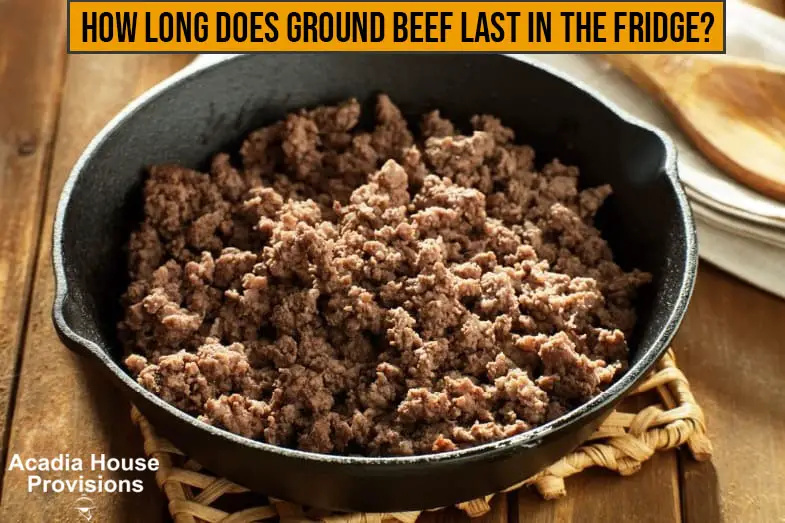Grass fed beef has become increasingly popular in recent years due to its numerous health and environmental benefits But like any fresh meat, proper storage is crucial to ensure safety and quality. So how long does grass fed beef last in the fridge?
The answer depends on a few key factors:
Raw vs. Cooked Grass Fed Beef
Raw and cooked grass fed beef have different recommended fridge life:
-
After being bought, raw grass-fed beef will last for one to two days in the fridge. The key is ensuring it is stored at 40°F or below.
-
Cooked grass fed beef will last 3-4 days in the fridge stored in airtight containers It’s important to let it cool to room temperature before refrigerating
Factors that Determine Fridge Life
There are a few key factors that influence how long grass fed beef will last in your fridge:
-
Freshness at purchase – Fresher beef that is properly handled will last longer. Buying from local farms or butchers will provide better freshness.
-
Proper temperature – Storing at 40°F or below preserves freshness and slows bacteria growth. Invest in a good fridge thermometer.
-
Preparation – How the raw beef is handled, stored, and prepared impacts shelf life. Follow good food safety practices.
-
Packaging – Re-packaging into airtight containers helps prolong freshness and prevents freezer burn.
How to Tell if Your Grass Fed Beef Has Spoiled
Always rely on your senses to determine if your grass fed beef has gone bad:
-
Change in color – Raw beef will turn more brown or grey. Cooked beef may turn green.
-
Texture changes – Raw beef will become slimy or overly sticky. Cooked beef may become dry and tough.
-
Off odors – Raw beef will start to smell sour or unpleasant. Trust your nose!
-
Mold growth – This is an obvious red flag that the beef has spoiled and should be discarded.
If in doubt, throw it out to be safe. The risks of foodborne illness are not worth it.
Proper Handling and Storage Tips
Follow these tips for safely handling and storing your grass fed beef:
-
Store raw beef on the bottom shelf of the fridge to prevent leaks from contaminating other food. Use a plate or tray to catch any drips.
-
Keep raw meats separate from other foods, especially ready-to-eat items like produce. Consider using different colored containers.
-
Freeze for longer term storage if you won’t use within recommended fridge times. Freeze in portioned packages for easy thawing.
-
Always thaw in the fridge, not on the counter. This helps inhibits bacteria growth.
-
Cook to proper internal temperatures, using a meat thermometer. Ground beef should reach 160°F and steaks 145°F.
-
Let cooked beef rest for 5-10 minutes before serving. This allows juices to redistribute evenly.
-
Refrigerate leftovers within 2 hours and store in shallow airtight containers. Don’t overload your fridge.
-
Label storage containers with dates so you track fridge life. First in, first out.
-
Never refreeze raw beef once it’s been thawed. Cooked beef can be safely refrozen.
By following these fridge storage guidelines and food safety tips, you can feel confident your grass fed beef will retain optimum freshness, nutrients, and taste.
Why Choose Grass Fed Beef? 7 Key Benefits
Understanding proper fridge storage times is just one reason grass fed beef is worth the switch. Here are 7 additional benefits of choosing grass fed over conventional beef:
-
Higher in omega-3 fatty acids – Grass fed cows produce beef with a higher ratio of anti-inflammatory omega-3s.
-
More antioxidants – Grass fed beef contains more vitamin E, beta-carotene, and other antioxidants.
-
Lower in saturated fats – Studies show grass fed beef has lower overall fat content and higher unsaturated fats.
-
No added hormones or antibiotics – Grass feeding eliminates the need for these additives commonly used in feedlot cattle.
-
Supports small local farms – Choosing grass fed beef helps sustain environmental stewardship.
-
Promotes animal welfare – Grass feeding allows cattle to graze freely and exhibit natural behaviors.
-
Enhanced taste and texture – The slow growth of grass fed cattle develops deeper beefy flavor.
Choosing locally sourced grass fed beef, handling it properly, and adhering to safe fridge storage times gives you the best eating experience while supporting your health and the environment.
Frequently Asked Questions
Still have questions about how long grass fed beef lasts? Here are answers to some commonly asked questions:
How can I tell when grass fed ground beef has gone bad?
Ground beef will turn brown or gray, smell unpleasant or sour, and become slimy in texture when it has spoiled. Discard immediately if you notice these signs.
Can I freeze grass fed beef to make it last longer?
Yes, freezing extends the shelf life of raw grass fed beef up to 6 months in an airtight freezer bag. Thaw frozen beef slowly in the fridge before cooking.
What is the best way to store cooked grass fed beef?
Store cooked grass fed beef in airtight, shallow containers to allow for rapid cooling. Refrigerating within 2 hours is critical to prevent bacteria growth.
If grass fed beef smells a little off, is it ok to cook and eat it?
No, do not risk eating beef with an off or sour odor. The bacteria that causes spoilage can persist even after cooking. Play it safe and throw it out.
Can I refreeze grass fed beef once it has been thawed?
Never refreeze raw beef after thawing, as bacteria will grow rapidly at unsafe temperatures. Cooked beef can be safely refrozen.
How can I keep my fridge below 40°F to store grass fed beef safely?
Invest in an inexpensive fridge thermometer to monitor the temperature. Adjust the temperature controls as needed to maintain consistent cold temps under 40°F.
Following proper grass fed beef fridge storage times, freezing guidelines, and food prep safety tips allows you to enjoy the delicious flavor and nutritional benefits of grass fed beef with complete confidence and peace of mind.

